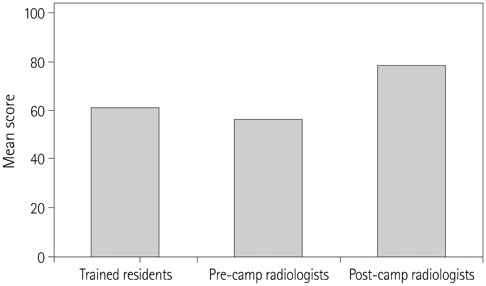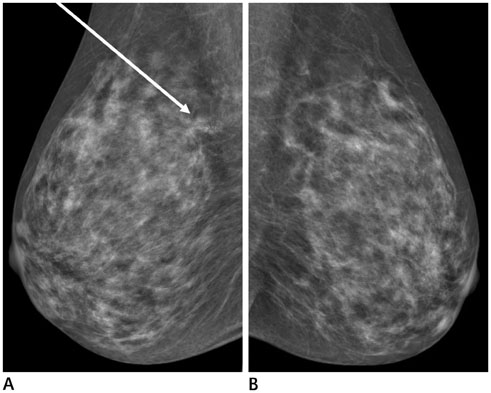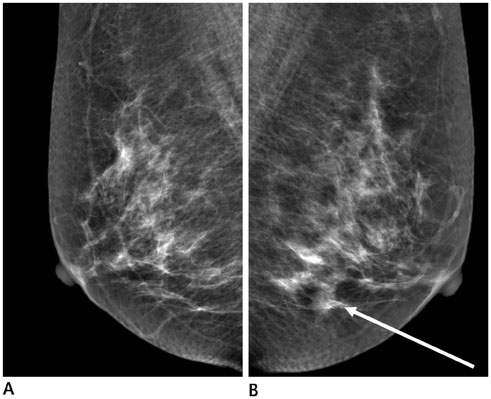J Korean Soc Radiol.
2014 Dec;71(6):288-295. 10.3348/jksr.2014.71.6.288.
Interpreting Performance of Mammograms by Radiology Residents Trained in Breast Imaging: Comparison with Radiologists Who Attended Mammography Boot Camp
- Affiliations
-
- 1Department of Radiology, Bucheon Hospital, Soonchunhyang University College of Medicine, Bucheon, Korea. grace@schmc.ac.kr
- 2Department of Radiology, Seoul St. Mary's Hospital, The Catholic University of Korea College of Medicine, Seoul, Korea.
- 3Department of Radiology, Eulji General Hospital, Eulji University College of Medicine, Seoul, Korea.
- 4Department of Radiology, Kangbuk Samsung Hospital, Sungkyunkwan University School of Medicine, Seoul, Korea.
- 5Department of Radiology, Haeundae Paik Hospital, Inje University College of Medicine, Busan, Korea.
- KMID: 1801551
- DOI: http://doi.org/10.3348/jksr.2014.71.6.288
Abstract
- PURPOSE
To compare the interpreting performance of mammograms between residents trained in breast imaging and radiologists who attended the mammography boot camp (MBC) suggesting directions for training in breast imaging.
MATERIALS AND METHODS
We compared the performance of 61 residents trained in breast imaging for more than 2 months at 21 institutions with that of 141 radiologists who attended MBC using the same test case series. We compared mean scores and rates of correct answers between the two groups and examined residents' mean scores varied by institution.
RESULTS
Residents' mean score was 60.9 +/- 12.2 and radiologists' mean scores were 56.0 +/- 12.2 (p = 0.004) and 78.3 +/- 9.2 (p < 0.001) before and after camp, respectively. Residents were superior to pre-camp radiologists in interpreting microcalcifications (70.5% vs. 56.4%; p < 0.001) and true-negative cases (71.8% vs. 59.2%; p < 0.001). They were inferior to post-camp radiologists in interpreting mass/asymmetry (56.7% vs. 86.6%; p < 0.001) and microcalcifications (70.5% vs. 90.3%; p < 0.001). The mean score of all institutions except one was 61.8 +/- 9.4.
CONCLUSION
Trained residents' interpreting performance of mammograms is superior to that of pre-camp radiologists but inferior to that of post-camp radiologists. Substantial training in interpreting mammograms during residency is suggested.
Figure
Reference
-
1. Suh M, Choi KS, Lee YY, Jun JK. Trends in cancer screening rates among Korean men and women: results from the Korean National Cancer Screening Survey, 2004-2012. Cancer Res Treat. 2013; 45:86–94.2. Park B, Choi KS, Lee YY, Jun JK, Seo HG. Cancer screening status in Korea, 2011: results from the Korean National Cancer Screening Survey. Asian Pac J Cancer Prev. 2012; 13:1187–1191.3. Seo HG, Park JH. Korea Ministry of Health & Welfare, National Cancer Center. Cancer facts & figures 2013. Goyang, Seoul: National Cancer Center, Ministry of Health & Welfare;2013.4. Kim Y, Jun JK, Choi KS, Lee HY, Park EC. Overview of the National Cancer Screening Programme and the cancer screening status in Korea. Asian Pac J Cancer Prev. 2011; 12:725–730.5. Kang MH, Park EC, Choi KS, Suh M, Jun JK, Cho E. The National Cancer Screening Program for breast cancer in the Republic of Korea: is it cost-effective? Asian Pac J Cancer Prev. 2013; 14:2059–2065.6. Ministry of health and welfare notice 2006-5. Available from: http://www.bokjiro.go.kr/policy/legislationView.do?board_sid=300&data_sid=151815&searchGroup=AR01&searchSort=REG_DESC&pageIndex=1&searchWrd=%EA%B2%80%EC%A7%84&searchCont=&pageUnit=10&searchProgrYn.7. Ministry of health and welfare notice 2002-23. Available from: http://www.mw.go.kr/front_new/jb/sjb0402vw.jsp?PAR_MENU_ID=03&MENU_ID=030402&BOARD_ID=220&BOARD_FLAG=03&CONT_SEQ=22366&page=1.8. Lee EH, Jun JK, Kim YM, Bae KK, Hwang KW, Choi BB, et al. Mammography boot camp to improve a quality of National Cancer Screening Program in Korea: a report about a test run in 2012. J Korean Soc Breast Screen. 2013; 10:162–168.9. Lee EH, Jun JK, Jung SE, Kim YM, Choi N. The efficacy of mammography boot camp to improve the performance of radiologists. Korean J Radiol. 2014; 15:578–585.10. Lee EH, Lyou CY. Radiology residents' performance in screening mammography interpretation. J Korean Soc Radiol. 2013; 68:333–341.11. ACR BI-RADS Committee. BI-RADS breast imaging and reporting data system: breast imaging atlas. 4th ed. Reston: American College of Radiology;2003.12. Brem RF, Baum J, Lechner M, Kaplan S, Souders S, Naul LG, et al. Improvement in sensitivity of screening mammography with computer-aided detection: a multiinstitutional trial. AJR Am J Roentgenol. 2003; 181:687–693.13. Rawashdeh MA, Lee WB, Bourne RM, Ryan EA, Pietrzyk MW, Reed WM, et al. Markers of good performance in mammography depend on number of annual readings. Radiology. 2013; 269:61–67.14. Miglioretti DL, Gard CC, Carney PA, Onega TL, Buist DS, Sickles EA, et al. When radiologists perform best: the learning curve in screening mammogram interpretation. Radiology. 2009; 253:632–640.
- Full Text Links
- Actions
-
Cited
- CITED
-
- Close
- Share
- Similar articles
-
- The Efficacy of Mammography Boot Camp to Improve the Performance of Radiologists
- Application of Artificial Intelligence in Breast Imaging: Current Landscape and Prospects
- Interpretive Performance and Inter-Observer Agreement on Digital Mammography Test Sets
- Applications of Artificial Intelligence in Mammography from a Development and Validation Perspective
- Radiology Residents' Performance in Screening Mammography Interpretation





